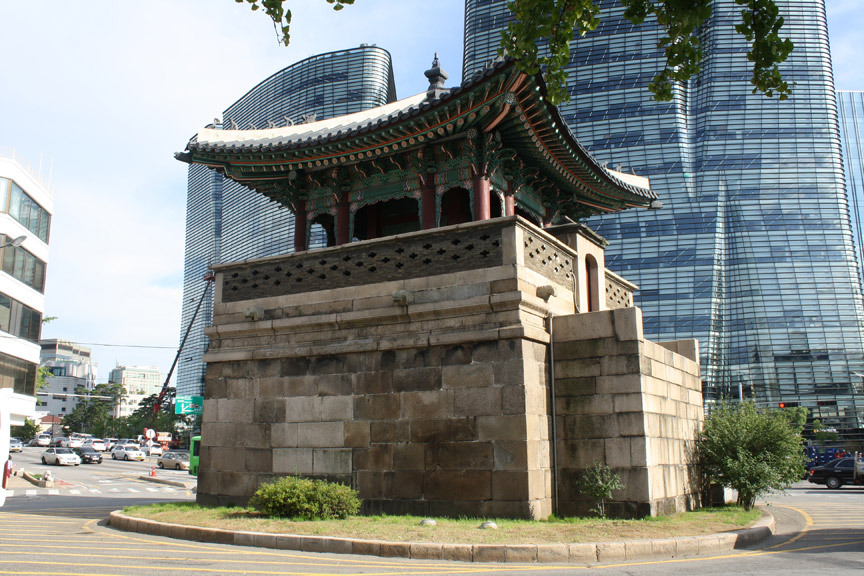Though an ancient city, Seoul has relatively few traces of its Joseon dynasty past. Here’s one, a guard station, outside the Gyeongbokgung palace, near the primary gallery district, with a modern office tower behind it.
Built during the Japanese occupation of the Korea penninsula (1910–45), the old city hall now looks as if it’s about to be swamped by an enormous wave—the new city hall, a structure designed by the iARC firm.
The Seoul Museum of Art, located near the Deoksugung Palace, is a functional building, which suited the needs of Mediacity Seoul. But the museum’s programming is currently inconsistent at best.
Among the many difficult to parse projects in the new-media-focused exhibition was Emergent Mind of City (EMC) (2012), a collaboration between artists, Jeong Han Kim and Bike Lab, and scientists, which “observes the city from the perspective of using data-flow instead of water-flow.”
In Romy Achituv’s Krapp’s Last Tape (2012) a stream of honey pouring over a table oscillates to the sound of an actor performing Beckett’s one act play.
Eye-Tracking Informatics (2011), by Seiko Mikami, appears to make line drawings in three-dimensional virtual space on a screen, based on the eye motions of the person in the chair.
Bang & Lee’s Lost in Translation (2012) spells out their intentions pretty clearly, using Google Translate, into several languages, including French: “Our philosophy is to change the internet, the way of life and language.”
A change of pace from the darkened rooms of Mediacity Seoul is Jinnie Seo’s Wave (2012), which covers the atrium of the Asan Institute for Policy Studies in semi-translucent colored vinyl panels, creating a bluish-green, aquatic atmosphere.
One of Gallery Hyundai’s three buildings in the Jongno area.
From Hyundai’s exhibition “Remember Me,” a detail of Seung-taek Lee’s sculpture Untitled (1987) comprised of tubes of wrapped paper dyed with colors.
The Artsonje center, which held Lee Bul’s first Korean museum show back in 1998.
Interior views of Lee’s 2012 exhibition, with Bunker (M. Bakhtin) (2007/2012) on the left, and the mirrored labyrinth Via Negativa (2012) on the right.
The second floor of Lee’s exhibition was dubbed “The Studio,” and featured 220 drawings, models and studies for her sculptural work of the last two decades. Here is an array of vomiting dogs.
Two of the three buildings in the Kukje gallery compound house video works by Kimsooja.
The Jongno neighborhood features both preserved historical buildings and ultra-modern gallery spaces.
Inside One and J Gallery were paintings and sculptures by Kang Hong-goo, examining shades of green, in painting, photography and sculptures.
At Plateau, an exhibition space at the Samsung corporate headquarters, the collection of Rodin’s muscular bronzes was complimented by a survey of the delicate conceptualism of Félix Gonzáles-Torres.
Interior of KIAF, with Yue Minjun’s laughing devils in the background and Yo Hong Ji’s creature made from recycled car tires.
A Lee Ufan painting, but one lacking the elder artist’s usual precision.
A four-panel abstraction made from the lining of envelopes by Haegue Yang.
Atelier Hermès is located in the Hermès store in Gangnam.
One of the three artists nominated for Hermès Foundation Missulsang 2012 is Jackson Hong, whose sculptures—models enlarged to 1.5 times their normal size—parody the idea of prototypes.
Inside the Leeum Samsung Museum, whose blue-chip collection includes Jeff Koons (center), Nam June-Paik (right) and Lee Bul (suspended above).
The Leeum hosted a large installation by Swiss mischief-maker Pipilotti Rist.
Also at the Leeum was “Artspectrum 2012,” a survey of young artists. Here is part of Kim Ji Eun’s 11-meter-tall drawing Some Watchtower (2012) made from woodgrain contact paper next to a mirrored cube covered in miniature bamboo scaffolding.
About an hour’s bus ride away from Seoul is Cheonan, the home base of Arario Gallery. In the sculpture courtyard is a 20-meter-tall sculpture by Arman consisting of 999 car axles stacked into a tower, as well as sculptures by Damian Hirst, Subodh Gupta and Arario’s owner, and artist, Ci Kim.
Kohei Nawa’s huge carved styrofoam “TRANS” sculptures consist of pairs of computer-rendered figures, one naturalistic and other abstracted to flat planes.
Ci Kim’s studio, located on the top floor of the Cheonan building, is filled with materials and works in progress.
Coming soon! Designer Yi Jeseok, also known as Jeski, created these large cheeky billboards (with strategically placed trees) to promote the opening of the new UUL National Art Museum, Seoul, in 2013.




